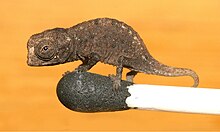Brookesia micra
| Brookesia micra | |
|---|---|

| |

| |
| Adult female in natural habitat (top), juvenile on match head (bottom) | |
| Scientific classification | |
| Domain: | Eukaryota |
| Kingdom: | Animalia |
| Phylum: | Chordata |
| Class: | Reptilia |
| Order: | Squamata |
| Suborder: | Iguania |
| Family: | Chamaeleonidae |
| Genus: | Brookesia |
| Species: | B. micra
|
| Binomial name | |
| Brookesia micra | |

| |
Brookesia micra, also known as the Nosy Hara leaf chameleon is a species of
Taxonomy
Brookesia micra was discovered and named by a team of researchers led by Frank Glaw of the Bavarian State Collection of Zoology.[3] Glaw and his colleagues have been conducting expeditions into the Malagasy forests for eight years.[4] Members of the species had previously been labelled as Brookesia sp. "Nosy Hara" in 2007 by Glaw and Vences.[2]
Etymology
The specific epithet of B. micra is a derivation of the Latin form of the Greek word "μικρός" (mikros), which means either "tiny" or "small" and refers to the small body size.[2]
Description
The males of Brookesia micra reach a maximum snout-vent length of 16 mm (0.63 in), and the total body length of both of the sexes is less than 30 mm (1.2 in), ranking it among the smallest amniote vertebrates found anywhere in the world.[2] Compared to Brookesia minima, B. micra has a shorter tail and a larger head.[2] Adults of B. micra also have orange tails, as opposed to an inconspicuous brown one.[2] The size of the lizard may be linked to its habitat, due to insular dwarfism.[5]
Distribution and habitat
Brookesia micra, together with three other species, were found in north Madagascar in 2005.
References
- Specific
- ^ Davies, Ella (15 February 2012). "Tiny lizards found in Madagascar". BBC Nature. BBC. Archived from the original on 11 September 2018. Retrieved 30 August 2018.
- ^ PMID 22348069.

- ^ Phelan, Jessica (15 February 2012). "Brookesia micra, world's smallest chameleon, discovered in Madagascar". GlobalPost. Archived from the original on 17 February 2012. Retrieved 15 February 2012.
- ^ Zukerman, Wendy (15 February 2012). "Itsy bitsy teeny weeny chameleons". New Scientist. Retrieved 15 February 2012.
- ^ Mann, Adam (14 February 2012). "World's Tiniest Chameleons Found in Madagascar". Wired. Retrieved 15 February 2012.
- ^ a b Mustain, Andrea (14 February 2012). "World's Tiniest Chameleon Discovered". Live Science. Archived from the original on 15 February 2012. Retrieved 15 February 2012.
- ^ "Brookesia micra, world's smallest chameleon, discovered in Madagascar". Public Radio International. Retrieved 2019-02-04.
- ^ Davies, Ella (15 February 2012). "Tiny lizards found in Madagascar". BBC Nature. Archived from the original on 11 September 2018. Retrieved 15 February 2012.
- ^ a b Villeneuve, Andrew (2017). "Habitat Selection and Population Density of the World's Smallest Chameleon, Brookesia micra, on Nosy Hara, Madagascar". Herpetological Conservation and Biology. 12: 334–341.
- ^ "World's tiniest chameleon discovered". Toronto Sun. Quebecor Media. 15 February 2012. Retrieved 15 February 2012.
- General
- PMID 22348069. Please check the source for the exact licensing terms.

